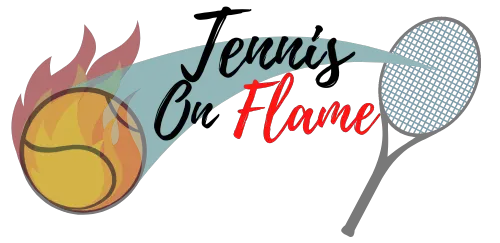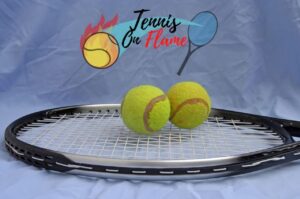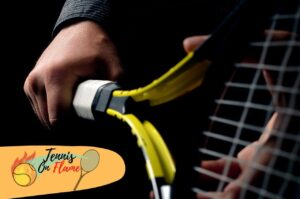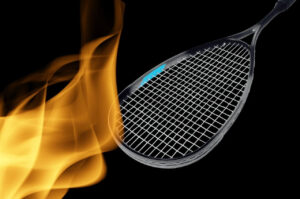Did you know that a tennis racket has different parts that make it up?
If you’re looking to purchase your first tennis racket or want to learn more about them, then read on.
In this blog post, we’ll introduce you to the tennis racket parts and explain how each one affects your game.
From the strings and grip to the frame and head, there’s a lot to consider when it comes to choosing a tennis racket.
So let’s get started!
What are the three main racket parts?
There are three main parts of the tennis racket: The Head, The Shaft, and The Handle.
The Head
This is where the strings of the racket are attached. It’s also the part that makes contact with the ball when you hit it.
The head of the racket largely affects performance and power.
Different rackets have different head sizes. The size of a racquet’s head typically ranges from 90 to 110 square inches, but there are also larger options available.
A larger head size provides a great sweet spot for optimal performance and a wider margin of error.
The Shaft
This is the long pole that connects the head to the handle.
The shaft is attached to the throat. The throat can be in an open or closed position.
The Handle
This is where you put your hand when hitting the ball. Most old wooden rackets had a leather handle grip, but nowadays, most rackets handle use a leather replacement such as vinyl,
to provide a comfortable grip.
Now that you know the three main parts of a tennis racket, let’s move on to meet the other parts of the tennis racket.
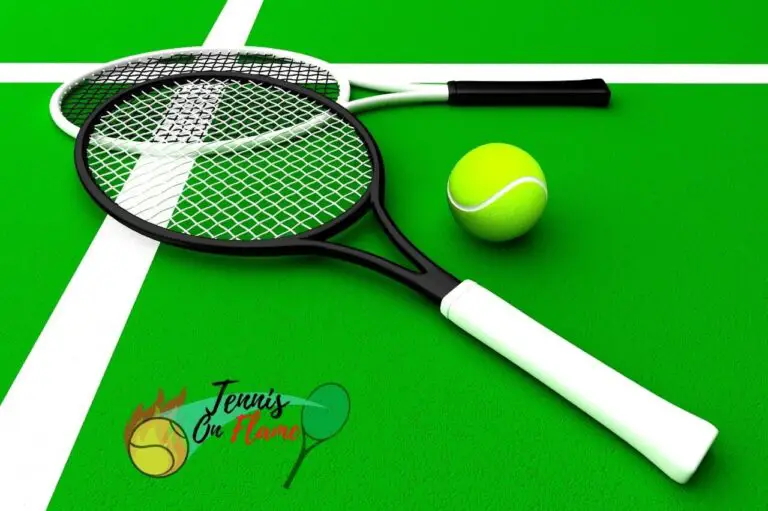
What are the other parts of the tennis racket?
The other parts of the racket include:
The Butt Cap
The butt cap is the plastic seal located at the bottom of a racket’s handle.
Some butt caps have trap doors that can be removed, If you take the trap door off, you can use that space to add weight and customize a racquet according to your preference.
The Butt
The end of the racket’s handle is called the butt, and it has a small flare to keep your grip tight and prevent your hand from slipping while you swing.
The grip
The grip of a tennis racket is the layer of cushioning material that covers the handle. It helps protect a player’s hand from injury and keeps the racket securely in place.
For your comfort, You can replace the standard grip with a replacement grip, or if you need more traction or want to absorb sweat better, you can replace the grip or add an overgrip.
The Grip Tape
Grip tape is a thin, soft layer of material that wraps around the top of the handle and helps keep your grip secure, and prevents it from coming undone.
The Collar
In addition to the standard grip tape, Many racquets have a rubber collar.
That collar is a small, thin layer of material that goes over the top of the grip tape to make sure it is extra secure.
You can also use this collar to hold an overgrip in place instead of using standard grip tape.
The Handle Bevels
A racquet’s octagonal handle helps prevent it from twisting or rotating when a player is holding it.
The Handle Bevels are helpful when learning how to hold a tennis racquet.
The Throat
The throat is the junction between the head and the shaft of a racket. On most rackets, the throat can be in an open or closed position.
The Throat is commonly called the “heart”.
The rim
The “rim” of a tennis racket is the outside edge of the tennis racket head–imagine it like the lip of a pool.
The beam
The beam of a tennis racquet is its side, which can be thick or thin depending on the type of racket, and it has a great impact on the tennis racket’s performance.
If you want more control over your shots, choose a racket with a thinner beam.
If you want more power, go for a thicker thinner beam.
The Grommet Strips
The racquet’s head is surrounded by plastic grommet strips.
The string must go through drilled holes on the side of the frame. To avoid having the string cut by the sharp edges, they are inserted into special ports on the side of the frame.
The Grommets
Grommets are small, round tunnels along a grommet strip that run through a frame.
The width or design of the grommets may change to allow free movement of the strings, or it might be changed to constrict their movement.
Power racquets have wider grommets to allow the strings room to move, while control racquets will have narrower grommets which help keep the string movement more restricted.
The Bumper Guard
The bumper guard is a small piece of plastic or rubber at the tip of the frame.
The first purpose of a bumper guard is to protect the outside strings on your racket frame from being damaged when it scrapes the ground. The strings also play a role in keeping the installed product secure.
The second purpose of the bumper guard is to protect your racket head from any potential damage, whether that be cracks or scrapes.
The strings
The strings, which are thin pieces of material are passed through the racket head, installed tautly across the head, and provide a flat surface for hitting the ball.
The gauge, thickness, and material of tennis string can greatly affect a racquet’s performance.
The tension of the strings on a racket can also be adjusted to customize its performance for your playing style.
The Main Strings
The vertical strings within the head of a tennis racquet are called the main strings.
The Cross Strings
The horizontal strings within the head of a tennis racquet are called cross strings.
The racket Face
The strings on a tennis racquet are interwoven to create a flat surface at the top of a tennis racquet designed to hit the ball when you swing – that surface is called the racket Face.
The size, shape, and material used in this area can all influence how much power or spin you get from your shots.
In conclusion
A tennis racket is a complex piece of equipment, with many different components that make it work.
These components are designed to help you hit the ball faster, farther, and with more control.
Understanding these parts will help you select the best racket for your game and maximize your potential on the court!
That’s all there is to it! Now that you know what parts make up a tennis racket, you’re one step closer to becoming an expert player.
I hope you enjoyed learning about the parts of the tennis racket.
If you have any further questions, please feel free to comment below, and I will be happy to answer you! 🙂
And make sure to check out my other blog posts for more informative guides.
Thanks for reading and happy playing!
